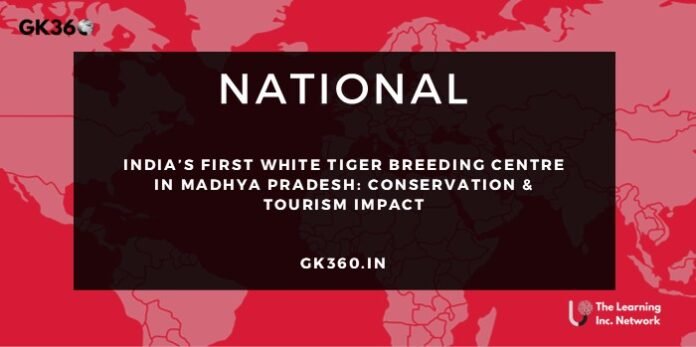India’s First White Tiger Breeding Centre in Madhya Pradesh: Conservation & Tourism Impact
Introduction
India is set to establish its first White Tiger Breeding Centre in Govindgarh, Rewa district, Madhya Pradesh, marking a significant step in wildlife conservation. The Central Zoo Authority (CZA) has approved the initiative, which aims to enhance biodiversity, boost eco-tourism, and create employment opportunities. Rewa holds historical significance as the birthplace of the world’s last known wild white tiger, Mohan, discovered in 1951. This initiative is expected to strengthen conservation efforts while promoting sustainable tourism in the region.

Table of Contents
- History of White Tigers in Rewa
- India’s First White Tiger Breeding Centre – Overview
- Conservation and Biodiversity Impact
- Eco-Tourism and Employment Opportunities
- Challenges & Future Prospects
- FAQs
- Conclusion & Call-to-Action
History of White Tigers in Rewa
Rewa has long been associated with white tigers, as it was home to Mohan, the last recorded wild white tiger. In 1951, Maharaja Martand Singh Judeo discovered Mohan in the Govindgarh forests, leading to a captive breeding program that resulted in the global spread of white tigers in zoos and safaris. The upcoming breeding center revives Rewa’s legacy, ensuring these majestic animals continue to thrive.
India’s First White Tiger Breeding Centre – Overview
Approval by Central Zoo Authority (CZA)
The project, originally proposed in 2011, has now received final approval from the CZA, reinforcing the government’s commitment to wildlife conservation.
Location & Infrastructure
The centre will be established in Govindgarh, located 10 km from the Mukundpur White Tiger Safari, Madhya Pradesh’s only white tiger tourism facility.
- It will include specialized enclosures, veterinary facilities, and research laboratories for genetic studies and breeding programs.
- The project will be integrated with the existing Maharaja Martand Singh Judeo White Tiger Safari and Zoo in Mukundpur under a revised master plan.
Conservation and Biodiversity Impact
The centre will play a crucial role in genetic preservation by maintaining healthy white tiger populations.
- It aims to enhance biodiversity by studying the species’ genetics, ensuring a sustainable population.
- The breeding program will adhere to scientific wildlife management practices to prevent issues like inbreeding, which can affect the health of captive white tigers.
- This initiative aligns with India’s broader wildlife conservation strategy, reinforcing the government’s commitment to protecting rare and endangered species.
Eco-Tourism and Employment Opportunities
The project is expected to boost wildlife tourism, attracting visitors to Rewa and Mukundpur, making the region a hub for white tiger enthusiasts.
- Local communities will benefit from job opportunities in conservation management, tourism, and hospitality sectors.
- The breeding centre’s establishment will encourage research and education, creating partnerships with zoological and wildlife institutions worldwide.
Challenges & Future Prospects
Key Challenges:
- Genetic Diversity Concerns: White tigers are a recessive genetic variant, and inbreeding risks must be carefully managed.
- Funding & Maintenance: Ensuring sustainable funding for long-term operations is crucial.
- Habitat Replication: Creating a naturalistic, enriched environment for the tigers to thrive in captivity.
Future Prospects:
- Expanding research into white tiger genetics for better conservation strategies.
- Developing partnerships with global zoos and wildlife research organizations.
- Exploring the feasibility of reintroducing captive-bred white tigers into controlled wildlife reserves.
FAQs
1. Why is Rewa important for white tigers?
Rewa is historically linked to the discovery of the last wild white tiger, Mohan, in 1951. The new breeding center aims to revive this legacy.
2. What is the purpose of the White Tiger Breeding Centre?
The center aims to conserve and manage white tiger populations, support research, and promote eco-tourism in the region.
3. Will the breeding center allow public visits?
Yes, the facility is expected to have controlled public access, with guided tours and educational programs.
4. How does this project benefit local communities?
The project will generate employment opportunities, promote wildlife tourism, and support conservation education.
5. How will the government ensure the ethical treatment of white tigers?
Strict wildlife conservation guidelines and veterinary care protocols will be followed to ensure the well-being of the tigers.
Conclusion & Call-to-Action
The establishment of India’s first White Tiger Breeding Centre in Madhya Pradesh is a historic step towards conserving these magnificent creatures. By integrating scientific conservation strategies, eco-tourism, and community involvement, the project will enhance India’s global reputation in wildlife conservation.
Explore more about wildlife conservation and India’s biodiversity efforts on GK360.in and stay updated on groundbreaking initiatives in the field.
Key Takeaways
| Aspect | Details |
|---|---|
| Why in the News? | India’s First White Tiger Breeding Centre Approved in MP. |
| Project | White tiger breeding and conservation centre. |
| Approval Authority | Central Zoo Authority (CZA). |
| Location | Govindgarh, Rewa district, MP. |
| Adjacent Safari | Mukundpur White Tiger Safari (10 km away). |
| Historical Significance | Rewa was home to Mohan, the last wild white tiger. |
| Government Statement | Dedicated to biodiversity conservation, job creation, and tourism boost. |
| Part of | Revised master plan for Mukundpur White Tiger Safari and Zoo. |
Related Terms:
- White Tiger Breeding Centre India
- White Tiger Conservation Rewa
- Central Zoo Authority India
- Madhya Pradesh Wildlife Tourism
- Mukundpur White Tiger Safari
- Rewa White Tiger History
- White Tiger Population in India
- Wildlife Conservation Madhya Pradesh
- Biodiversity Projects India
- White Tigers in Zoos






